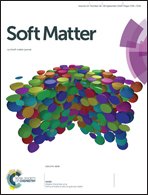Tailoring water stability of cellulose nanopaper by surface functionalization†
Abstract
Cellulose nanopaper (CNP) features appealing properties, including transparency, flatness, a low thermal expansion coefficient and thermal stability, often outperforming conventional paper. However, free-standing crystalline cellulose films usually swell in water or upon moisture sorption, compromising part of their outstanding properties. This remains a major problem whenever working in a water environment is required. Freestanding cellulose nanopaper is prepared by solution casting water suspensions of cellulose nanocrystals with an average width of 10 nm and an average aspect ratio of 28, isolated from Avicel by acid hydrolysis and extensively characterized by AFM and FE-SEM measurements and GPC detection of their degree of polymerization. We demonstrate by elemental analyses, FT-IR, Raman spectroscopy, XRD measurements and water contact angle detection that wet treatment with lauroyl chloride results in surface hydrophobization of nanopaper. The hydrophobized nanopaper, C12-CNP, shows a more compact surface morphology than the starting CNP, due to the effect of chemical functionalization, and presents enhanced resistance to water, as assessed by electrochemical permeation experiments. The new hydrophobized nanopaper is a promising substrate for thin film devices designed to work in a humid environment.



 Please wait while we load your content...
Please wait while we load your content...